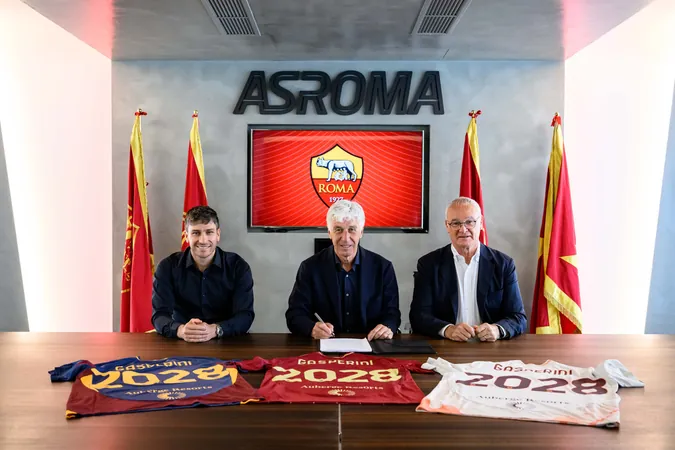
Revolutionizing Range: GM Introduces Groundbreaking 400-Mile LMR EV Batteries
2025-05-13
Author: Emily
GM and LG Push the Boundaries of Electric Vehicle Technology
General Motors is making headlines by joining forces with LG to develop innovative lithium manganese-rich (LMR) batteries, set to revolutionize the electric vehicle (EV) market. With claims of increased safety, enhanced energy density, and reduced costs, this new technology aims to provide consumers with electric trucks and SUVs that can reach an astonishing 400 miles on a single charge.
Aiming for a 2028 Launch
GM has announced its ambitious goal to be the first automaker to incorporate LMR batteries into its EV lineup, with commercial production slated to kick off in the United States by 2028. Interestingly, Ford has also jumped on the LMR bandwagon but won’t begin until 2030, giving GM a potential head start.
A Cobalt-Free Future?
Traditionally, EV batteries utilize a combination of nickel, cobalt, and manganese in their cathodes, but cobalt—often dubbed the 'blood diamond of batteries' due to ethical mining concerns—remains prohibitively expensive. In response, GM and industry giants like Tesla are racing to create cobalt-free alternatives. Enter LMR batteries, which cleverly substitute cobalt with a larger quantity of manganese. This shift not only promises a lower cost but also enhanced performance, as manganese is more abundant and cheaper.
Engineering Breakthroughs in Battery Design
Thanks to collaborative innovation at GM and LG, approximately 300 prototypes of full-size LMR battery cells have been developed. GM's battery engineer, Andrew Oury, humorously notes, "We like to joke that it’s as cheap as dirt," emphasizing manganese's low cost.
Evolving Range and Cost Efficiency
Currently, GM’s electric Chevys and Cadillacs harness high-nickel batteries, offering a range of about 300 to 320 miles. The new LMR batteries are not only denser but are also designed with a prismatic shape, allowing for greater space efficiency and potentially unlocking the 400-mile range. This ease of manufacturing could pave the way for more affordable EV options, tackling one of the industry's biggest challenges.
Lowering Costs, Boosting Growth
Kurt Kelty, GM’s VP for batteries, highlights that reducing battery costs is crucial for boosting EV adoption. Currently, batteries account for 30 to 40 percent of vehicle prices, and steep discounts in this area could mean lower costs for consumers. Kelty indicates, "If we can significantly drop those costs, it leads to a more accessible EV landscape."
Production Plans and Challenges Ahead
The cells will be produced through Ultium Cells, a joint venture between GM and LG, with preproduction expected to begin in late 2027. GM plans to finalize designs at its Battery Cell Development Center in Michigan and LG’s facility, as they tackle the hurdles associated with mass-producing LMR batteries.
Future-Proofing Against Material Constraints
As tensions surrounding international trade rise, particularly with China, which dominates over 70% of global lithium-ion battery production, GM is strategically localizing its battery material sourcing. Kelty states, "We expect our localization of materials for the battery supply chain to increase between now and 2028," positioning GM for a sustainable and cost-effective future.
Innovation Meets Determination
While challenges remain, such as potential capacity loss in LMR materials, GM expresses confidence in overcoming these obstacles, projecting performance levels akin to their existing high-nickel batteries, even in extreme conditions. With decades of research coming to fruition, GM is primed to lead in the EV space with this groundbreaking technology.









 Brasil (PT)
Brasil (PT)
 Canada (EN)
Canada (EN)
 Chile (ES)
Chile (ES)
 Česko (CS)
Česko (CS)
 대한민국 (KO)
대한민국 (KO)
 España (ES)
España (ES)
 France (FR)
France (FR)
 Hong Kong (EN)
Hong Kong (EN)
 Italia (IT)
Italia (IT)
 日本 (JA)
日本 (JA)
 Magyarország (HU)
Magyarország (HU)
 Norge (NO)
Norge (NO)
 Polska (PL)
Polska (PL)
 Schweiz (DE)
Schweiz (DE)
 Singapore (EN)
Singapore (EN)
 Sverige (SV)
Sverige (SV)
 Suomi (FI)
Suomi (FI)
 Türkiye (TR)
Türkiye (TR)
 الإمارات العربية المتحدة (AR)
الإمارات العربية المتحدة (AR)